HR Skills, Personal Development, and Organisational Learning Report
VerifiedAdded on 2020/12/09
|12
|3780
|458
Report
AI Summary
This report examines the essential skills, knowledge, and behaviors required of an HR professional, using Whirlpool as a case study. It explores key areas such as legal knowledge, business acumen, communication, leadership, and conflict management. The report includes a personal skills audit, identifying strengths and weaknesses, and a professional development plan to address skill gaps. It differentiates between individual and organizational learning, training, and development, highlighting their respective objectives and methodologies. Furthermore, the report analyzes the need for continuous learning within an organization, addressing factors like declining productivity and technological advancements. It also investigates the role of high-performance work practices (HPW) in employee engagement and details different approaches to performance management. The report offers a comprehensive overview of HR practices, providing valuable insights for understanding and improving HR functions within a global organization.
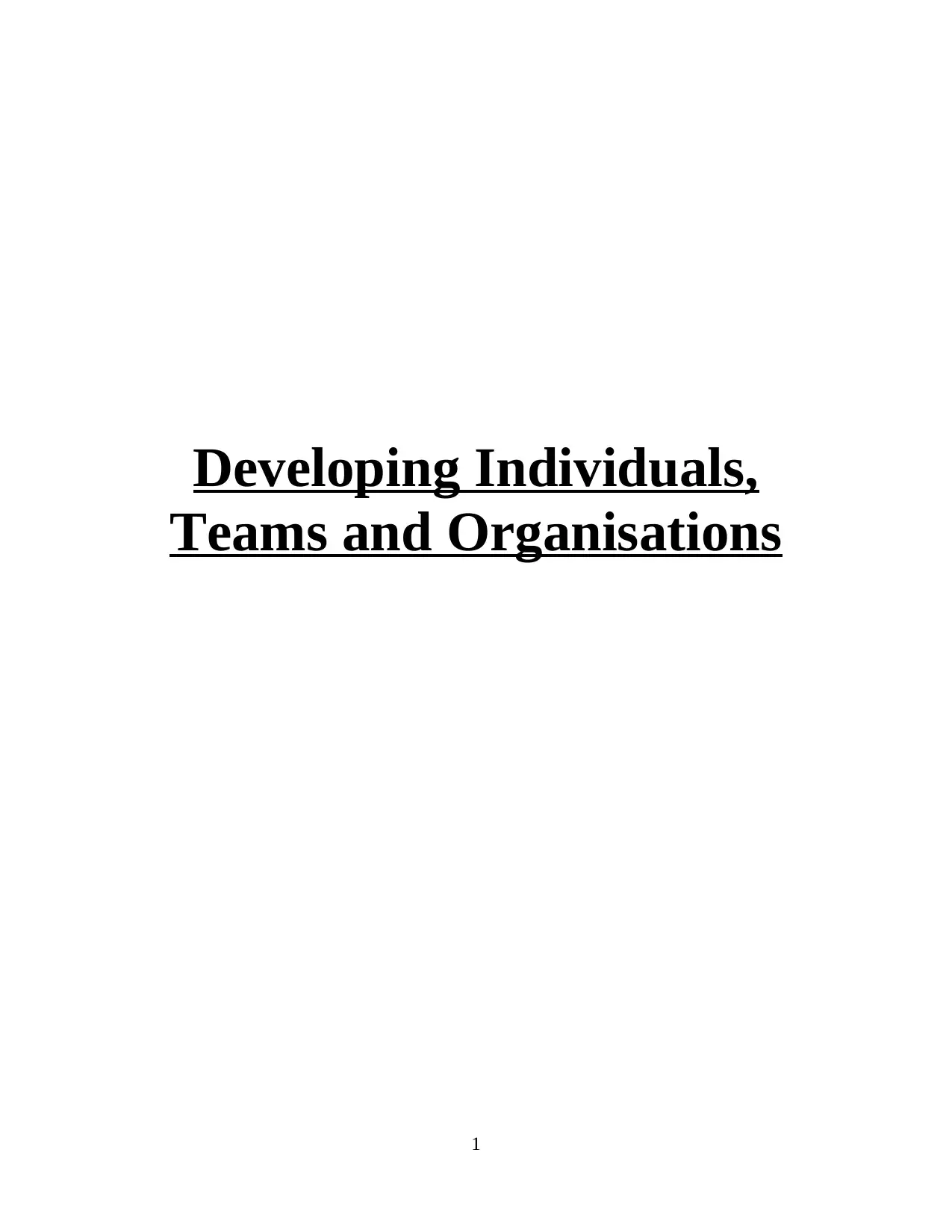
Developing Individuals,
Teams and Organisations
1
Teams and Organisations
1
Paraphrase This Document
Need a fresh take? Get an instant paraphrase of this document with our AI Paraphraser
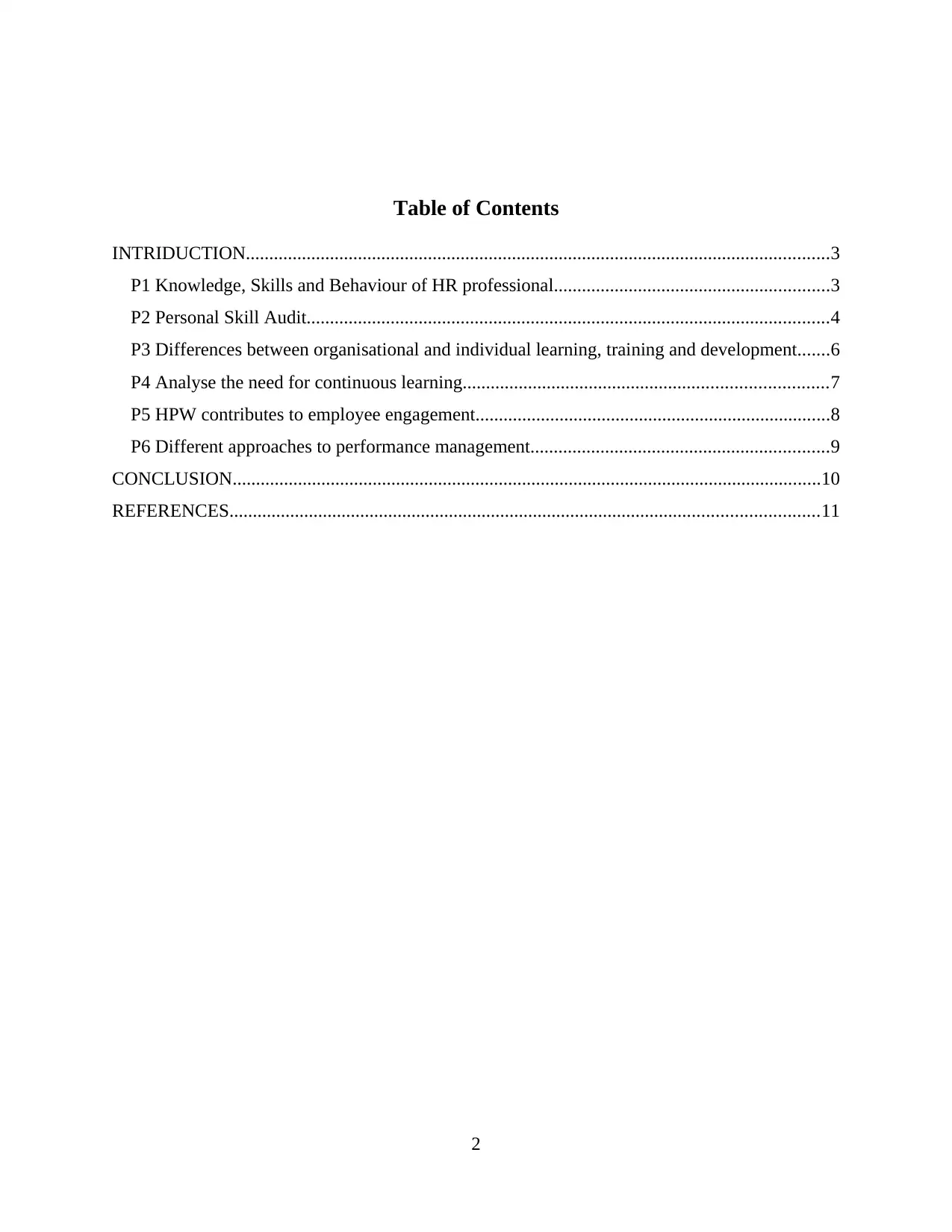
Table of Contents
INTRIDUCTION.............................................................................................................................3
P1 Knowledge, Skills and Behaviour of HR professional...........................................................3
P2 Personal Skill Audit................................................................................................................4
P3 Differences between organisational and individual learning, training and development.......6
P4 Analyse the need for continuous learning..............................................................................7
P5 HPW contributes to employee engagement............................................................................8
P6 Different approaches to performance management................................................................9
CONCLUSION..............................................................................................................................10
REFERENCES..............................................................................................................................11
2
INTRIDUCTION.............................................................................................................................3
P1 Knowledge, Skills and Behaviour of HR professional...........................................................3
P2 Personal Skill Audit................................................................................................................4
P3 Differences between organisational and individual learning, training and development.......6
P4 Analyse the need for continuous learning..............................................................................7
P5 HPW contributes to employee engagement............................................................................8
P6 Different approaches to performance management................................................................9
CONCLUSION..............................................................................................................................10
REFERENCES..............................................................................................................................11
2
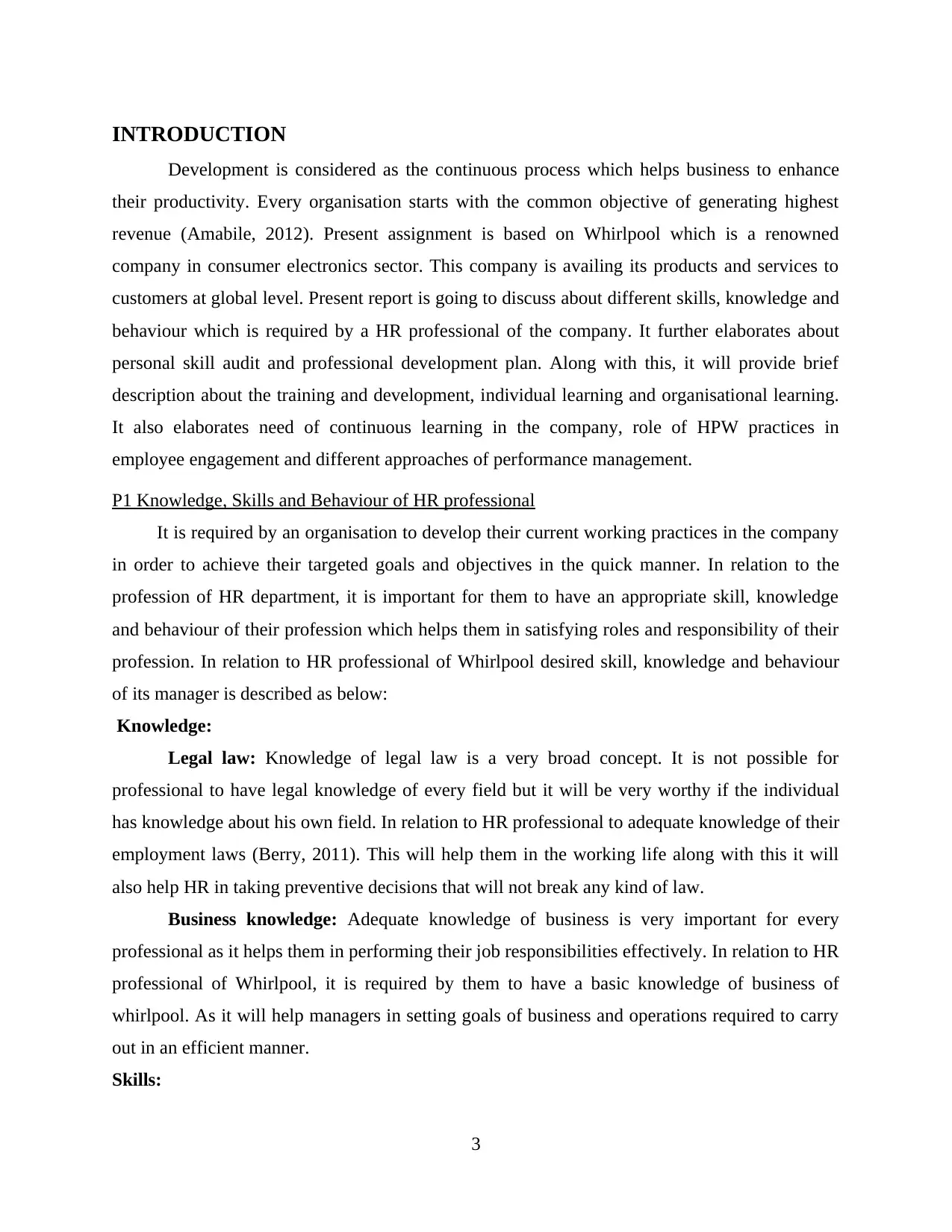
INTRODUCTION
Development is considered as the continuous process which helps business to enhance
their productivity. Every organisation starts with the common objective of generating highest
revenue (Amabile, 2012). Present assignment is based on Whirlpool which is a renowned
company in consumer electronics sector. This company is availing its products and services to
customers at global level. Present report is going to discuss about different skills, knowledge and
behaviour which is required by a HR professional of the company. It further elaborates about
personal skill audit and professional development plan. Along with this, it will provide brief
description about the training and development, individual learning and organisational learning.
It also elaborates need of continuous learning in the company, role of HPW practices in
employee engagement and different approaches of performance management.
P1 Knowledge, Skills and Behaviour of HR professional
It is required by an organisation to develop their current working practices in the company
in order to achieve their targeted goals and objectives in the quick manner. In relation to the
profession of HR department, it is important for them to have an appropriate skill, knowledge
and behaviour of their profession which helps them in satisfying roles and responsibility of their
profession. In relation to HR professional of Whirlpool desired skill, knowledge and behaviour
of its manager is described as below:
Knowledge:
Legal law: Knowledge of legal law is a very broad concept. It is not possible for
professional to have legal knowledge of every field but it will be very worthy if the individual
has knowledge about his own field. In relation to HR professional to adequate knowledge of their
employment laws (Berry, 2011). This will help them in the working life along with this it will
also help HR in taking preventive decisions that will not break any kind of law.
Business knowledge: Adequate knowledge of business is very important for every
professional as it helps them in performing their job responsibilities effectively. In relation to HR
professional of Whirlpool, it is required by them to have a basic knowledge of business of
whirlpool. As it will help managers in setting goals of business and operations required to carry
out in an efficient manner.
Skills:
3
Development is considered as the continuous process which helps business to enhance
their productivity. Every organisation starts with the common objective of generating highest
revenue (Amabile, 2012). Present assignment is based on Whirlpool which is a renowned
company in consumer electronics sector. This company is availing its products and services to
customers at global level. Present report is going to discuss about different skills, knowledge and
behaviour which is required by a HR professional of the company. It further elaborates about
personal skill audit and professional development plan. Along with this, it will provide brief
description about the training and development, individual learning and organisational learning.
It also elaborates need of continuous learning in the company, role of HPW practices in
employee engagement and different approaches of performance management.
P1 Knowledge, Skills and Behaviour of HR professional
It is required by an organisation to develop their current working practices in the company
in order to achieve their targeted goals and objectives in the quick manner. In relation to the
profession of HR department, it is important for them to have an appropriate skill, knowledge
and behaviour of their profession which helps them in satisfying roles and responsibility of their
profession. In relation to HR professional of Whirlpool desired skill, knowledge and behaviour
of its manager is described as below:
Knowledge:
Legal law: Knowledge of legal law is a very broad concept. It is not possible for
professional to have legal knowledge of every field but it will be very worthy if the individual
has knowledge about his own field. In relation to HR professional to adequate knowledge of their
employment laws (Berry, 2011). This will help them in the working life along with this it will
also help HR in taking preventive decisions that will not break any kind of law.
Business knowledge: Adequate knowledge of business is very important for every
professional as it helps them in performing their job responsibilities effectively. In relation to HR
professional of Whirlpool, it is required by them to have a basic knowledge of business of
whirlpool. As it will help managers in setting goals of business and operations required to carry
out in an efficient manner.
Skills:
3
⊘ This is a preview!⊘
Do you want full access?
Subscribe today to unlock all pages.

Trusted by 1+ million students worldwide
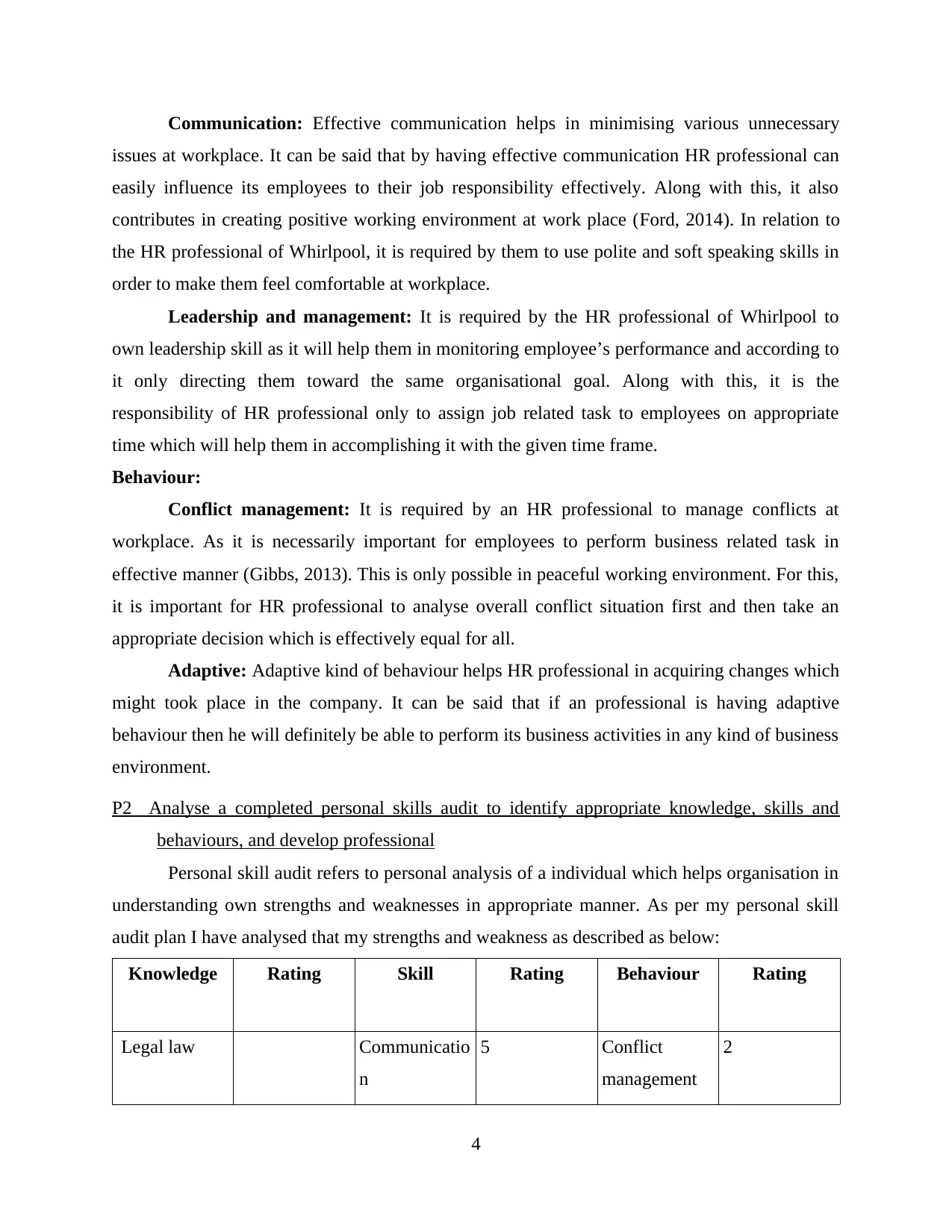
Communication: Effective communication helps in minimising various unnecessary
issues at workplace. It can be said that by having effective communication HR professional can
easily influence its employees to their job responsibility effectively. Along with this, it also
contributes in creating positive working environment at work place (Ford, 2014). In relation to
the HR professional of Whirlpool, it is required by them to use polite and soft speaking skills in
order to make them feel comfortable at workplace.
Leadership and management: It is required by the HR professional of Whirlpool to
own leadership skill as it will help them in monitoring employee’s performance and according to
it only directing them toward the same organisational goal. Along with this, it is the
responsibility of HR professional only to assign job related task to employees on appropriate
time which will help them in accomplishing it with the given time frame.
Behaviour:
Conflict management: It is required by an HR professional to manage conflicts at
workplace. As it is necessarily important for employees to perform business related task in
effective manner (Gibbs, 2013). This is only possible in peaceful working environment. For this,
it is important for HR professional to analyse overall conflict situation first and then take an
appropriate decision which is effectively equal for all.
Adaptive: Adaptive kind of behaviour helps HR professional in acquiring changes which
might took place in the company. It can be said that if an professional is having adaptive
behaviour then he will definitely be able to perform its business activities in any kind of business
environment.
P2 Analyse a completed personal skills audit to identify appropriate knowledge, skills and
behaviours, and develop professional
Personal skill audit refers to personal analysis of a individual which helps organisation in
understanding own strengths and weaknesses in appropriate manner. As per my personal skill
audit plan I have analysed that my strengths and weakness as described as below:
Knowledge Rating Skill Rating Behaviour Rating
Legal law Communicatio
n
5 Conflict
management
2
4
issues at workplace. It can be said that by having effective communication HR professional can
easily influence its employees to their job responsibility effectively. Along with this, it also
contributes in creating positive working environment at work place (Ford, 2014). In relation to
the HR professional of Whirlpool, it is required by them to use polite and soft speaking skills in
order to make them feel comfortable at workplace.
Leadership and management: It is required by the HR professional of Whirlpool to
own leadership skill as it will help them in monitoring employee’s performance and according to
it only directing them toward the same organisational goal. Along with this, it is the
responsibility of HR professional only to assign job related task to employees on appropriate
time which will help them in accomplishing it with the given time frame.
Behaviour:
Conflict management: It is required by an HR professional to manage conflicts at
workplace. As it is necessarily important for employees to perform business related task in
effective manner (Gibbs, 2013). This is only possible in peaceful working environment. For this,
it is important for HR professional to analyse overall conflict situation first and then take an
appropriate decision which is effectively equal for all.
Adaptive: Adaptive kind of behaviour helps HR professional in acquiring changes which
might took place in the company. It can be said that if an professional is having adaptive
behaviour then he will definitely be able to perform its business activities in any kind of business
environment.
P2 Analyse a completed personal skills audit to identify appropriate knowledge, skills and
behaviours, and develop professional
Personal skill audit refers to personal analysis of a individual which helps organisation in
understanding own strengths and weaknesses in appropriate manner. As per my personal skill
audit plan I have analysed that my strengths and weakness as described as below:
Knowledge Rating Skill Rating Behaviour Rating
Legal law Communicatio
n
5 Conflict
management
2
4
Paraphrase This Document
Need a fresh take? Get an instant paraphrase of this document with our AI Paraphraser
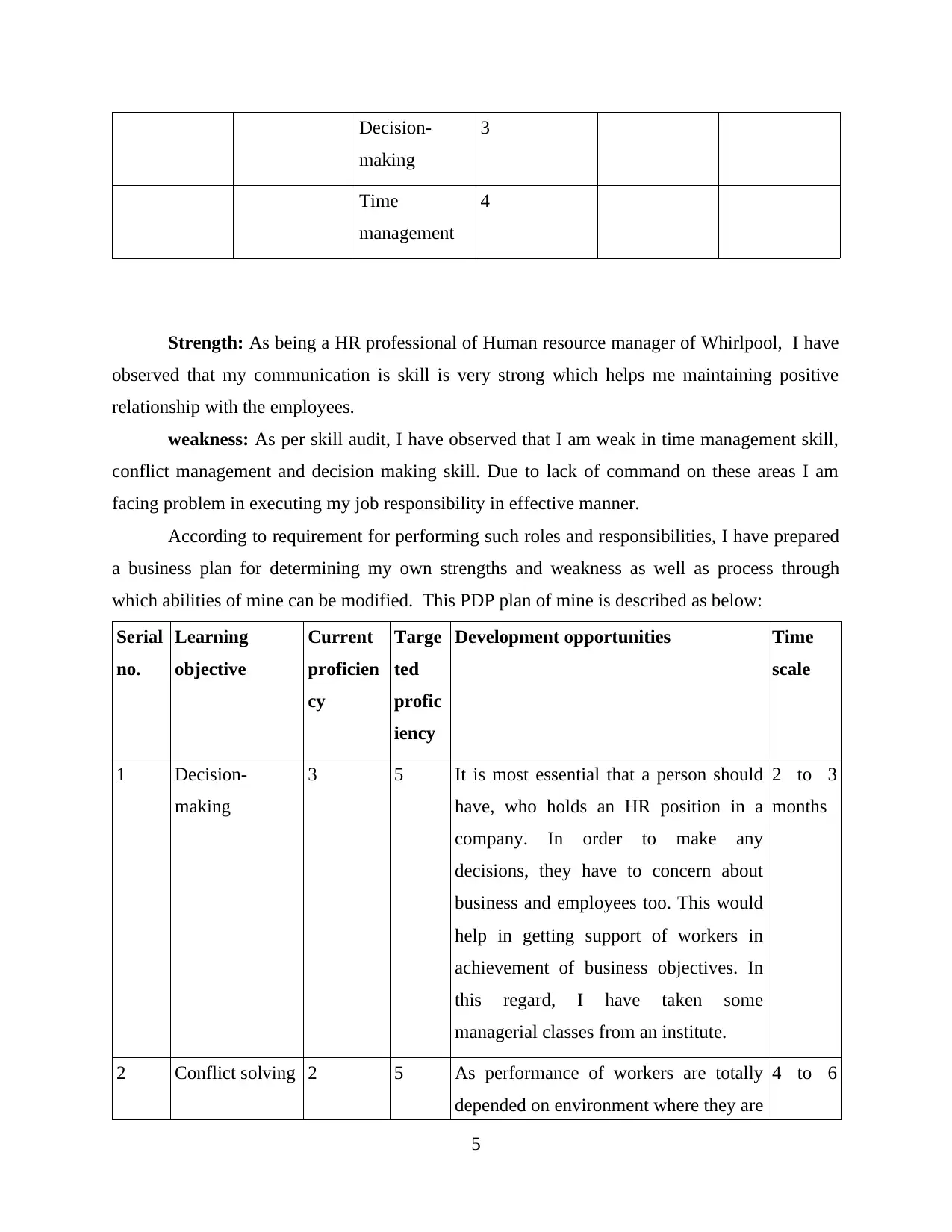
Decision-
making
3
Time
management
4
Strength: As being a HR professional of Human resource manager of Whirlpool, I have
observed that my communication is skill is very strong which helps me maintaining positive
relationship with the employees.
weakness: As per skill audit, I have observed that I am weak in time management skill,
conflict management and decision making skill. Due to lack of command on these areas I am
facing problem in executing my job responsibility in effective manner.
According to requirement for performing such roles and responsibilities, I have prepared
a business plan for determining my own strengths and weakness as well as process through
which abilities of mine can be modified. This PDP plan of mine is described as below:
Serial
no.
Learning
objective
Current
proficien
cy
Targe
ted
profic
iency
Development opportunities Time
scale
1 Decision-
making
3 5 It is most essential that a person should
have, who holds an HR position in a
company. In order to make any
decisions, they have to concern about
business and employees too. This would
help in getting support of workers in
achievement of business objectives. In
this regard, I have taken some
managerial classes from an institute.
2 to 3
months
2 Conflict solving 2 5 As performance of workers are totally
depended on environment where they are
4 to 6
5
making
3
Time
management
4
Strength: As being a HR professional of Human resource manager of Whirlpool, I have
observed that my communication is skill is very strong which helps me maintaining positive
relationship with the employees.
weakness: As per skill audit, I have observed that I am weak in time management skill,
conflict management and decision making skill. Due to lack of command on these areas I am
facing problem in executing my job responsibility in effective manner.
According to requirement for performing such roles and responsibilities, I have prepared
a business plan for determining my own strengths and weakness as well as process through
which abilities of mine can be modified. This PDP plan of mine is described as below:
Serial
no.
Learning
objective
Current
proficien
cy
Targe
ted
profic
iency
Development opportunities Time
scale
1 Decision-
making
3 5 It is most essential that a person should
have, who holds an HR position in a
company. In order to make any
decisions, they have to concern about
business and employees too. This would
help in getting support of workers in
achievement of business objectives. In
this regard, I have taken some
managerial classes from an institute.
2 to 3
months
2 Conflict solving 2 5 As performance of workers are totally
depended on environment where they are
4 to 6
5
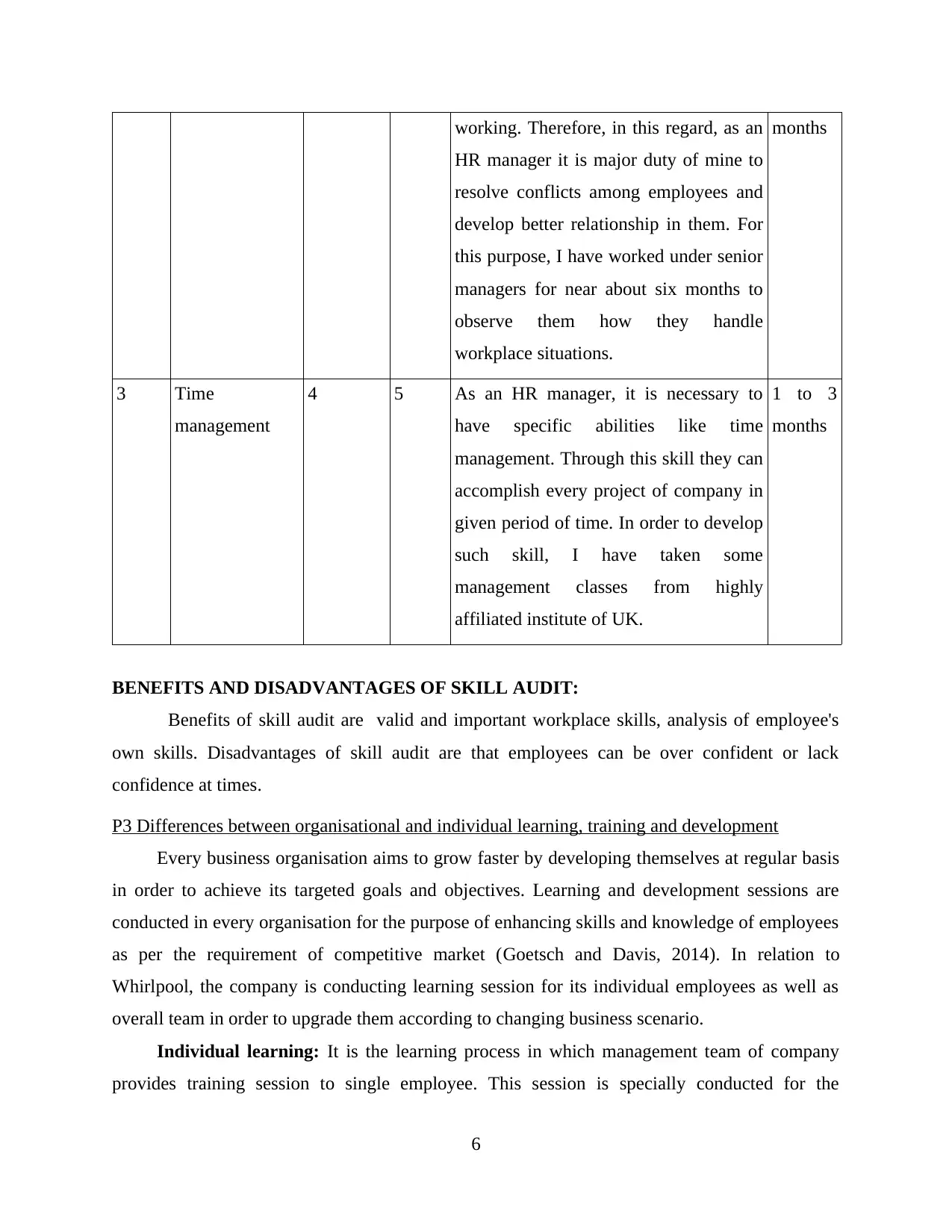
working. Therefore, in this regard, as an
HR manager it is major duty of mine to
resolve conflicts among employees and
develop better relationship in them. For
this purpose, I have worked under senior
managers for near about six months to
observe them how they handle
workplace situations.
months
3 Time
management
4 5 As an HR manager, it is necessary to
have specific abilities like time
management. Through this skill they can
accomplish every project of company in
given period of time. In order to develop
such skill, I have taken some
management classes from highly
affiliated institute of UK.
1 to 3
months
BENEFITS AND DISADVANTAGES OF SKILL AUDIT:
Benefits of skill audit are valid and important workplace skills, analysis of employee's
own skills. Disadvantages of skill audit are that employees can be over confident or lack
confidence at times.
P3 Differences between organisational and individual learning, training and development
Every business organisation aims to grow faster by developing themselves at regular basis
in order to achieve its targeted goals and objectives. Learning and development sessions are
conducted in every organisation for the purpose of enhancing skills and knowledge of employees
as per the requirement of competitive market (Goetsch and Davis, 2014). In relation to
Whirlpool, the company is conducting learning session for its individual employees as well as
overall team in order to upgrade them according to changing business scenario.
Individual learning: It is the learning process in which management team of company
provides training session to single employee. This session is specially conducted for the
6
HR manager it is major duty of mine to
resolve conflicts among employees and
develop better relationship in them. For
this purpose, I have worked under senior
managers for near about six months to
observe them how they handle
workplace situations.
months
3 Time
management
4 5 As an HR manager, it is necessary to
have specific abilities like time
management. Through this skill they can
accomplish every project of company in
given period of time. In order to develop
such skill, I have taken some
management classes from highly
affiliated institute of UK.
1 to 3
months
BENEFITS AND DISADVANTAGES OF SKILL AUDIT:
Benefits of skill audit are valid and important workplace skills, analysis of employee's
own skills. Disadvantages of skill audit are that employees can be over confident or lack
confidence at times.
P3 Differences between organisational and individual learning, training and development
Every business organisation aims to grow faster by developing themselves at regular basis
in order to achieve its targeted goals and objectives. Learning and development sessions are
conducted in every organisation for the purpose of enhancing skills and knowledge of employees
as per the requirement of competitive market (Goetsch and Davis, 2014). In relation to
Whirlpool, the company is conducting learning session for its individual employees as well as
overall team in order to upgrade them according to changing business scenario.
Individual learning: It is the learning process in which management team of company
provides training session to single employee. This session is specially conducted for the
6
⊘ This is a preview!⊘
Do you want full access?
Subscribe today to unlock all pages.

Trusted by 1+ million students worldwide
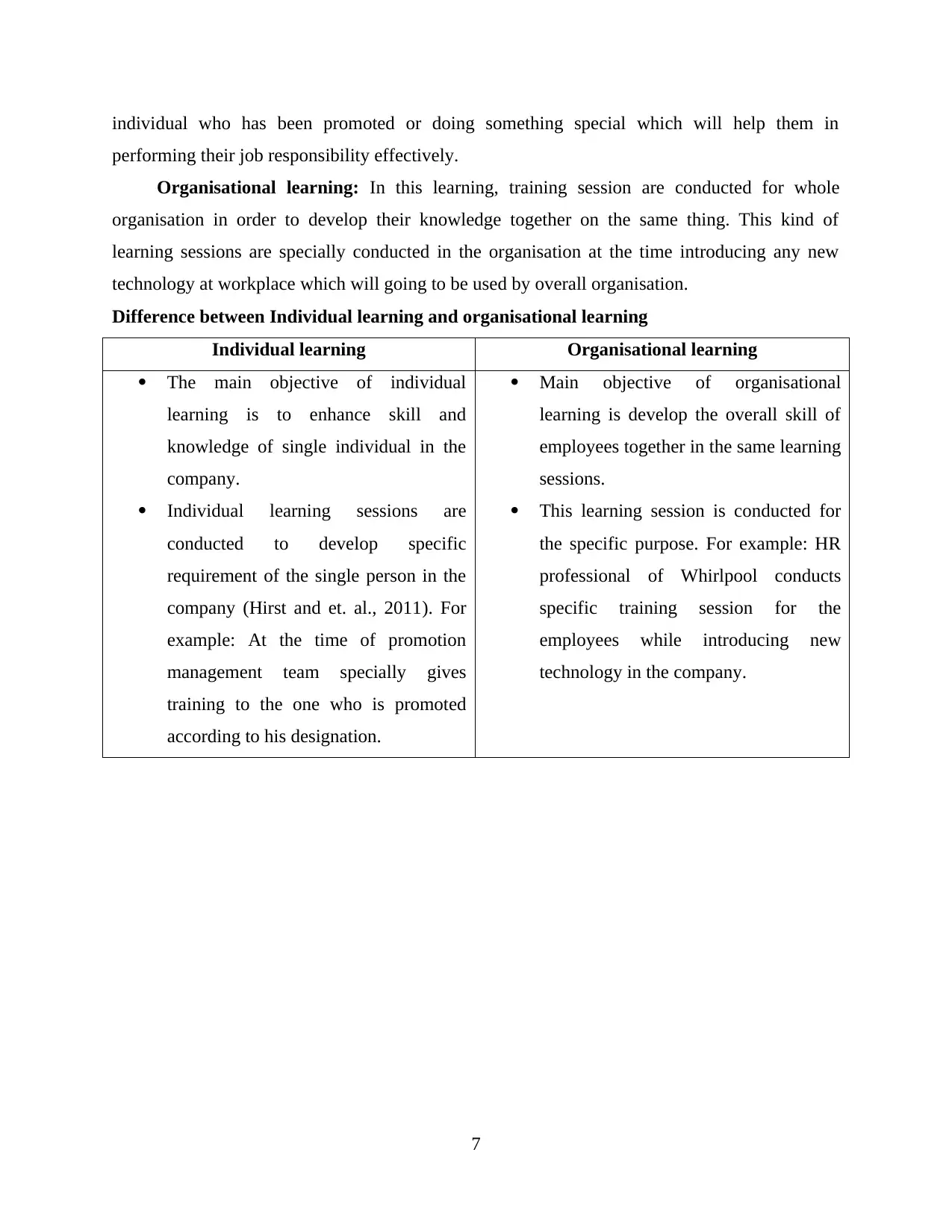
individual who has been promoted or doing something special which will help them in
performing their job responsibility effectively.
Organisational learning: In this learning, training session are conducted for whole
organisation in order to develop their knowledge together on the same thing. This kind of
learning sessions are specially conducted in the organisation at the time introducing any new
technology at workplace which will going to be used by overall organisation.
Difference between Individual learning and organisational learning
Individual learning Organisational learning
The main objective of individual
learning is to enhance skill and
knowledge of single individual in the
company.
Individual learning sessions are
conducted to develop specific
requirement of the single person in the
company (Hirst and et. al., 2011). For
example: At the time of promotion
management team specially gives
training to the one who is promoted
according to his designation.
Main objective of organisational
learning is develop the overall skill of
employees together in the same learning
sessions.
This learning session is conducted for
the specific purpose. For example: HR
professional of Whirlpool conducts
specific training session for the
employees while introducing new
technology in the company.
7
performing their job responsibility effectively.
Organisational learning: In this learning, training session are conducted for whole
organisation in order to develop their knowledge together on the same thing. This kind of
learning sessions are specially conducted in the organisation at the time introducing any new
technology at workplace which will going to be used by overall organisation.
Difference between Individual learning and organisational learning
Individual learning Organisational learning
The main objective of individual
learning is to enhance skill and
knowledge of single individual in the
company.
Individual learning sessions are
conducted to develop specific
requirement of the single person in the
company (Hirst and et. al., 2011). For
example: At the time of promotion
management team specially gives
training to the one who is promoted
according to his designation.
Main objective of organisational
learning is develop the overall skill of
employees together in the same learning
sessions.
This learning session is conducted for
the specific purpose. For example: HR
professional of Whirlpool conducts
specific training session for the
employees while introducing new
technology in the company.
7
Paraphrase This Document
Need a fresh take? Get an instant paraphrase of this document with our AI Paraphraser
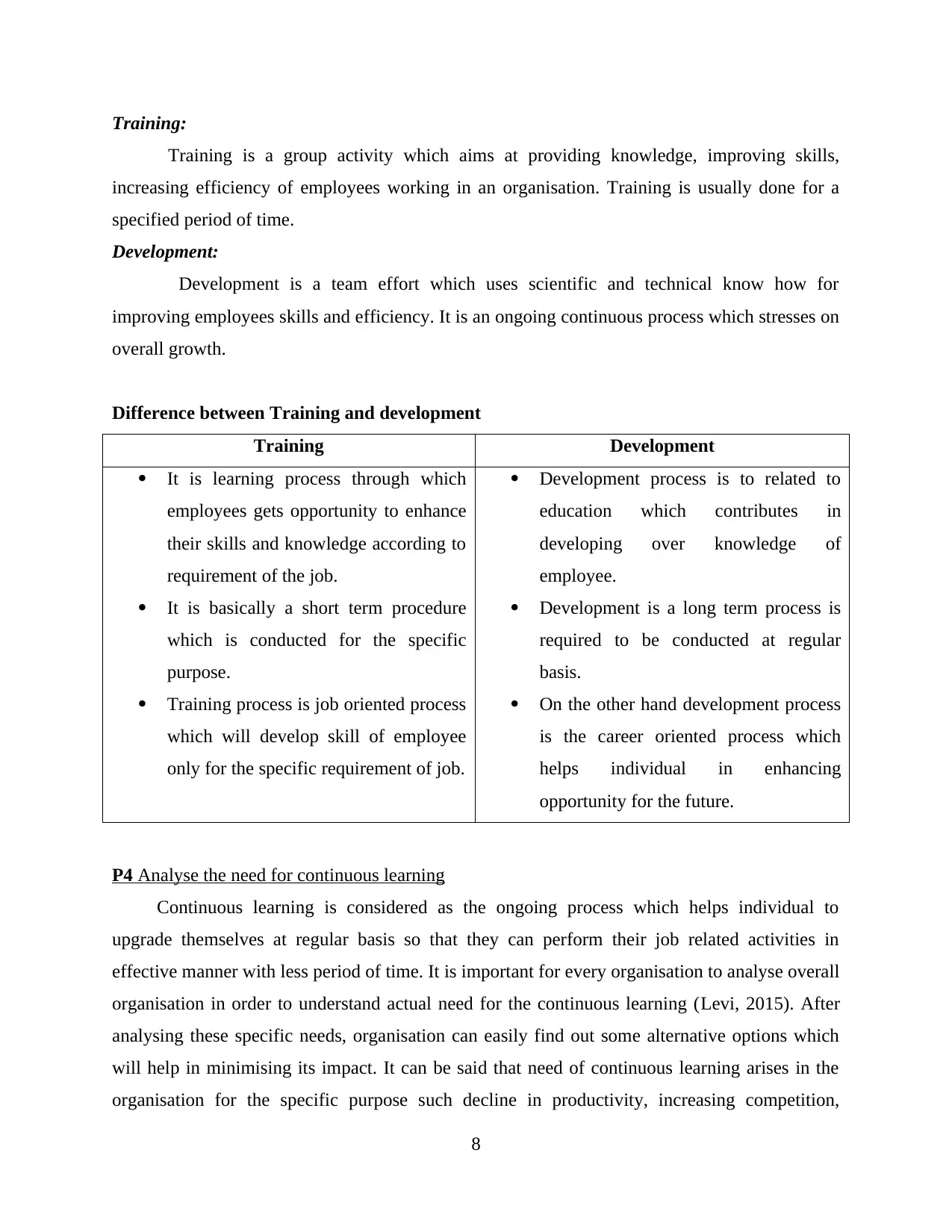
Training:
Training is a group activity which aims at providing knowledge, improving skills,
increasing efficiency of employees working in an organisation. Training is usually done for a
specified period of time.
Development:
Development is a team effort which uses scientific and technical know how for
improving employees skills and efficiency. It is an ongoing continuous process which stresses on
overall growth.
Difference between Training and development
Training Development
It is learning process through which
employees gets opportunity to enhance
their skills and knowledge according to
requirement of the job.
It is basically a short term procedure
which is conducted for the specific
purpose.
Training process is job oriented process
which will develop skill of employee
only for the specific requirement of job.
Development process is to related to
education which contributes in
developing over knowledge of
employee.
Development is a long term process is
required to be conducted at regular
basis.
On the other hand development process
is the career oriented process which
helps individual in enhancing
opportunity for the future.
P4 Analyse the need for continuous learning
Continuous learning is considered as the ongoing process which helps individual to
upgrade themselves at regular basis so that they can perform their job related activities in
effective manner with less period of time. It is important for every organisation to analyse overall
organisation in order to understand actual need for the continuous learning (Levi, 2015). After
analysing these specific needs, organisation can easily find out some alternative options which
will help in minimising its impact. It can be said that need of continuous learning arises in the
organisation for the specific purpose such decline in productivity, increasing competition,
8
Training is a group activity which aims at providing knowledge, improving skills,
increasing efficiency of employees working in an organisation. Training is usually done for a
specified period of time.
Development:
Development is a team effort which uses scientific and technical know how for
improving employees skills and efficiency. It is an ongoing continuous process which stresses on
overall growth.
Difference between Training and development
Training Development
It is learning process through which
employees gets opportunity to enhance
their skills and knowledge according to
requirement of the job.
It is basically a short term procedure
which is conducted for the specific
purpose.
Training process is job oriented process
which will develop skill of employee
only for the specific requirement of job.
Development process is to related to
education which contributes in
developing over knowledge of
employee.
Development is a long term process is
required to be conducted at regular
basis.
On the other hand development process
is the career oriented process which
helps individual in enhancing
opportunity for the future.
P4 Analyse the need for continuous learning
Continuous learning is considered as the ongoing process which helps individual to
upgrade themselves at regular basis so that they can perform their job related activities in
effective manner with less period of time. It is important for every organisation to analyse overall
organisation in order to understand actual need for the continuous learning (Levi, 2015). After
analysing these specific needs, organisation can easily find out some alternative options which
will help in minimising its impact. It can be said that need of continuous learning arises in the
organisation for the specific purpose such decline in productivity, increasing competition,
8
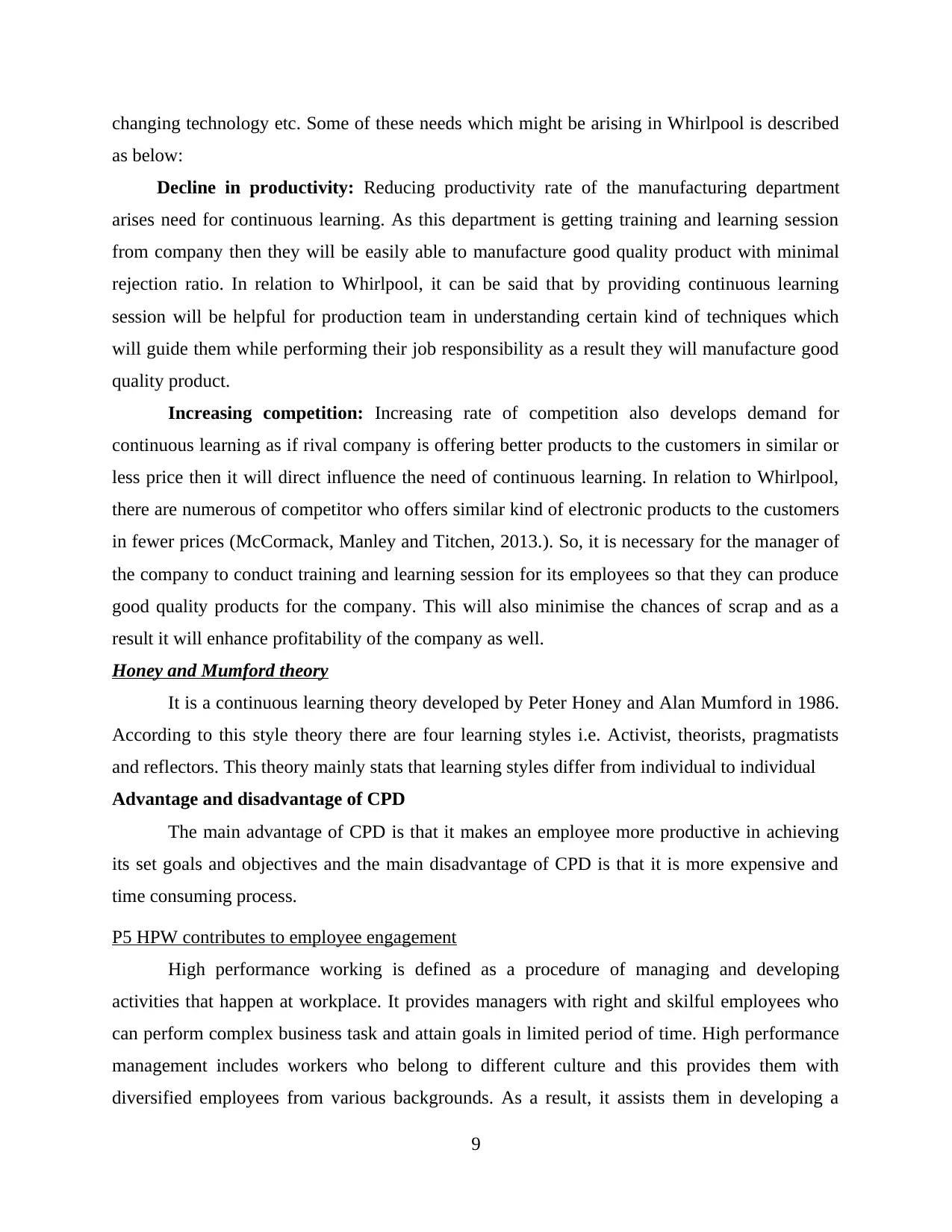
changing technology etc. Some of these needs which might be arising in Whirlpool is described
as below:
Decline in productivity: Reducing productivity rate of the manufacturing department
arises need for continuous learning. As this department is getting training and learning session
from company then they will be easily able to manufacture good quality product with minimal
rejection ratio. In relation to Whirlpool, it can be said that by providing continuous learning
session will be helpful for production team in understanding certain kind of techniques which
will guide them while performing their job responsibility as a result they will manufacture good
quality product.
Increasing competition: Increasing rate of competition also develops demand for
continuous learning as if rival company is offering better products to the customers in similar or
less price then it will direct influence the need of continuous learning. In relation to Whirlpool,
there are numerous of competitor who offers similar kind of electronic products to the customers
in fewer prices (McCormack, Manley and Titchen, 2013.). So, it is necessary for the manager of
the company to conduct training and learning session for its employees so that they can produce
good quality products for the company. This will also minimise the chances of scrap and as a
result it will enhance profitability of the company as well.
Honey and Mumford theory
It is a continuous learning theory developed by Peter Honey and Alan Mumford in 1986.
According to this style theory there are four learning styles i.e. Activist, theorists, pragmatists
and reflectors. This theory mainly stats that learning styles differ from individual to individual
Advantage and disadvantage of CPD
The main advantage of CPD is that it makes an employee more productive in achieving
its set goals and objectives and the main disadvantage of CPD is that it is more expensive and
time consuming process.
P5 HPW contributes to employee engagement
High performance working is defined as a procedure of managing and developing
activities that happen at workplace. It provides managers with right and skilful employees who
can perform complex business task and attain goals in limited period of time. High performance
management includes workers who belong to different culture and this provides them with
diversified employees from various backgrounds. As a result, it assists them in developing a
9
as below:
Decline in productivity: Reducing productivity rate of the manufacturing department
arises need for continuous learning. As this department is getting training and learning session
from company then they will be easily able to manufacture good quality product with minimal
rejection ratio. In relation to Whirlpool, it can be said that by providing continuous learning
session will be helpful for production team in understanding certain kind of techniques which
will guide them while performing their job responsibility as a result they will manufacture good
quality product.
Increasing competition: Increasing rate of competition also develops demand for
continuous learning as if rival company is offering better products to the customers in similar or
less price then it will direct influence the need of continuous learning. In relation to Whirlpool,
there are numerous of competitor who offers similar kind of electronic products to the customers
in fewer prices (McCormack, Manley and Titchen, 2013.). So, it is necessary for the manager of
the company to conduct training and learning session for its employees so that they can produce
good quality products for the company. This will also minimise the chances of scrap and as a
result it will enhance profitability of the company as well.
Honey and Mumford theory
It is a continuous learning theory developed by Peter Honey and Alan Mumford in 1986.
According to this style theory there are four learning styles i.e. Activist, theorists, pragmatists
and reflectors. This theory mainly stats that learning styles differ from individual to individual
Advantage and disadvantage of CPD
The main advantage of CPD is that it makes an employee more productive in achieving
its set goals and objectives and the main disadvantage of CPD is that it is more expensive and
time consuming process.
P5 HPW contributes to employee engagement
High performance working is defined as a procedure of managing and developing
activities that happen at workplace. It provides managers with right and skilful employees who
can perform complex business task and attain goals in limited period of time. High performance
management includes workers who belong to different culture and this provides them with
diversified employees from various backgrounds. As a result, it assists them in developing a
9
⊘ This is a preview!⊘
Do you want full access?
Subscribe today to unlock all pages.

Trusted by 1+ million students worldwide
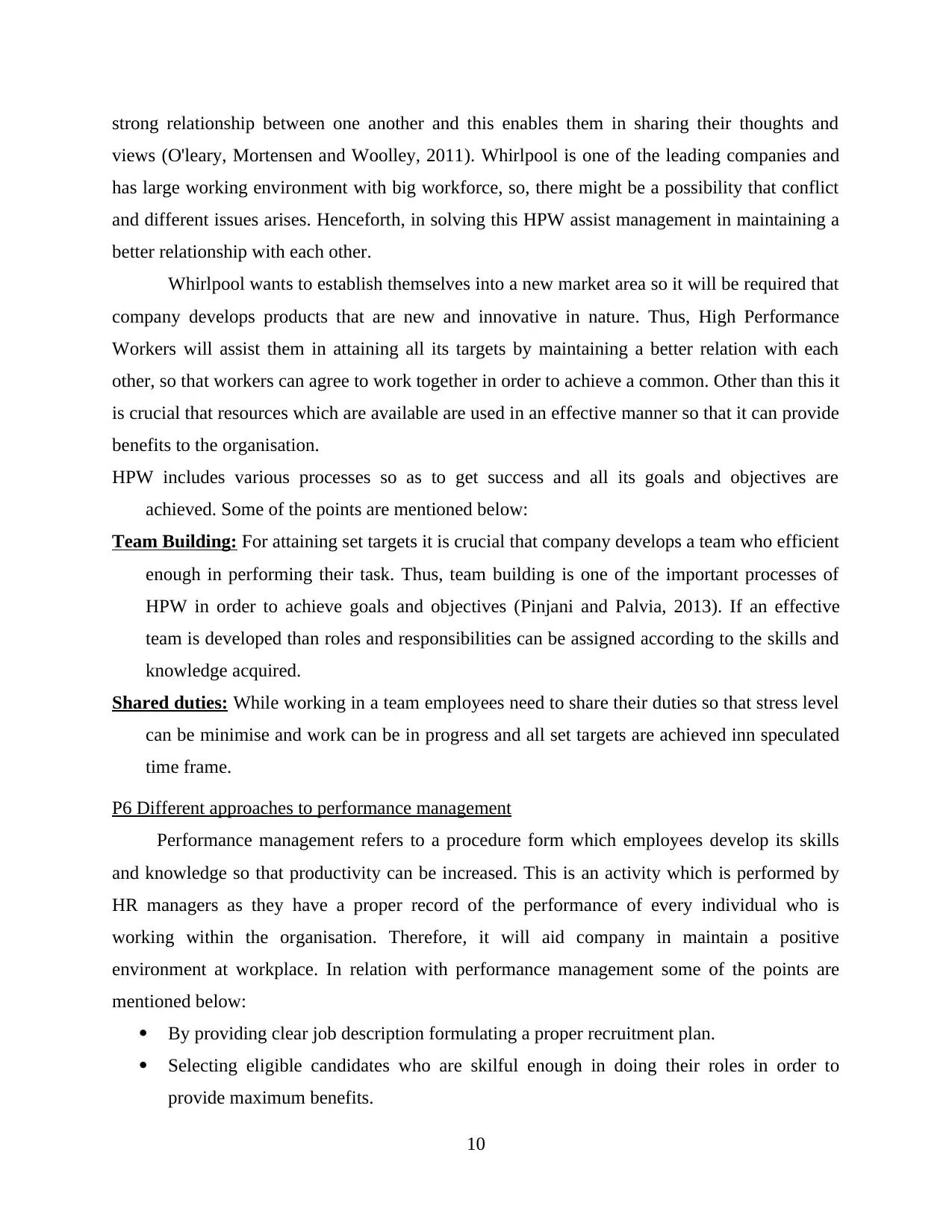
strong relationship between one another and this enables them in sharing their thoughts and
views (O'leary, Mortensen and Woolley, 2011). Whirlpool is one of the leading companies and
has large working environment with big workforce, so, there might be a possibility that conflict
and different issues arises. Henceforth, in solving this HPW assist management in maintaining a
better relationship with each other.
Whirlpool wants to establish themselves into a new market area so it will be required that
company develops products that are new and innovative in nature. Thus, High Performance
Workers will assist them in attaining all its targets by maintaining a better relation with each
other, so that workers can agree to work together in order to achieve a common. Other than this it
is crucial that resources which are available are used in an effective manner so that it can provide
benefits to the organisation.
HPW includes various processes so as to get success and all its goals and objectives are
achieved. Some of the points are mentioned below:
Team Building: For attaining set targets it is crucial that company develops a team who efficient
enough in performing their task. Thus, team building is one of the important processes of
HPW in order to achieve goals and objectives (Pinjani and Palvia, 2013). If an effective
team is developed than roles and responsibilities can be assigned according to the skills and
knowledge acquired.
Shared duties: While working in a team employees need to share their duties so that stress level
can be minimise and work can be in progress and all set targets are achieved inn speculated
time frame.
P6 Different approaches to performance management
Performance management refers to a procedure form which employees develop its skills
and knowledge so that productivity can be increased. This is an activity which is performed by
HR managers as they have a proper record of the performance of every individual who is
working within the organisation. Therefore, it will aid company in maintain a positive
environment at workplace. In relation with performance management some of the points are
mentioned below:
By providing clear job description formulating a proper recruitment plan.
Selecting eligible candidates who are skilful enough in doing their roles in order to
provide maximum benefits.
10
views (O'leary, Mortensen and Woolley, 2011). Whirlpool is one of the leading companies and
has large working environment with big workforce, so, there might be a possibility that conflict
and different issues arises. Henceforth, in solving this HPW assist management in maintaining a
better relationship with each other.
Whirlpool wants to establish themselves into a new market area so it will be required that
company develops products that are new and innovative in nature. Thus, High Performance
Workers will assist them in attaining all its targets by maintaining a better relation with each
other, so that workers can agree to work together in order to achieve a common. Other than this it
is crucial that resources which are available are used in an effective manner so that it can provide
benefits to the organisation.
HPW includes various processes so as to get success and all its goals and objectives are
achieved. Some of the points are mentioned below:
Team Building: For attaining set targets it is crucial that company develops a team who efficient
enough in performing their task. Thus, team building is one of the important processes of
HPW in order to achieve goals and objectives (Pinjani and Palvia, 2013). If an effective
team is developed than roles and responsibilities can be assigned according to the skills and
knowledge acquired.
Shared duties: While working in a team employees need to share their duties so that stress level
can be minimise and work can be in progress and all set targets are achieved inn speculated
time frame.
P6 Different approaches to performance management
Performance management refers to a procedure form which employees develop its skills
and knowledge so that productivity can be increased. This is an activity which is performed by
HR managers as they have a proper record of the performance of every individual who is
working within the organisation. Therefore, it will aid company in maintain a positive
environment at workplace. In relation with performance management some of the points are
mentioned below:
By providing clear job description formulating a proper recruitment plan.
Selecting eligible candidates who are skilful enough in doing their roles in order to
provide maximum benefits.
10
Paraphrase This Document
Need a fresh take? Get an instant paraphrase of this document with our AI Paraphraser
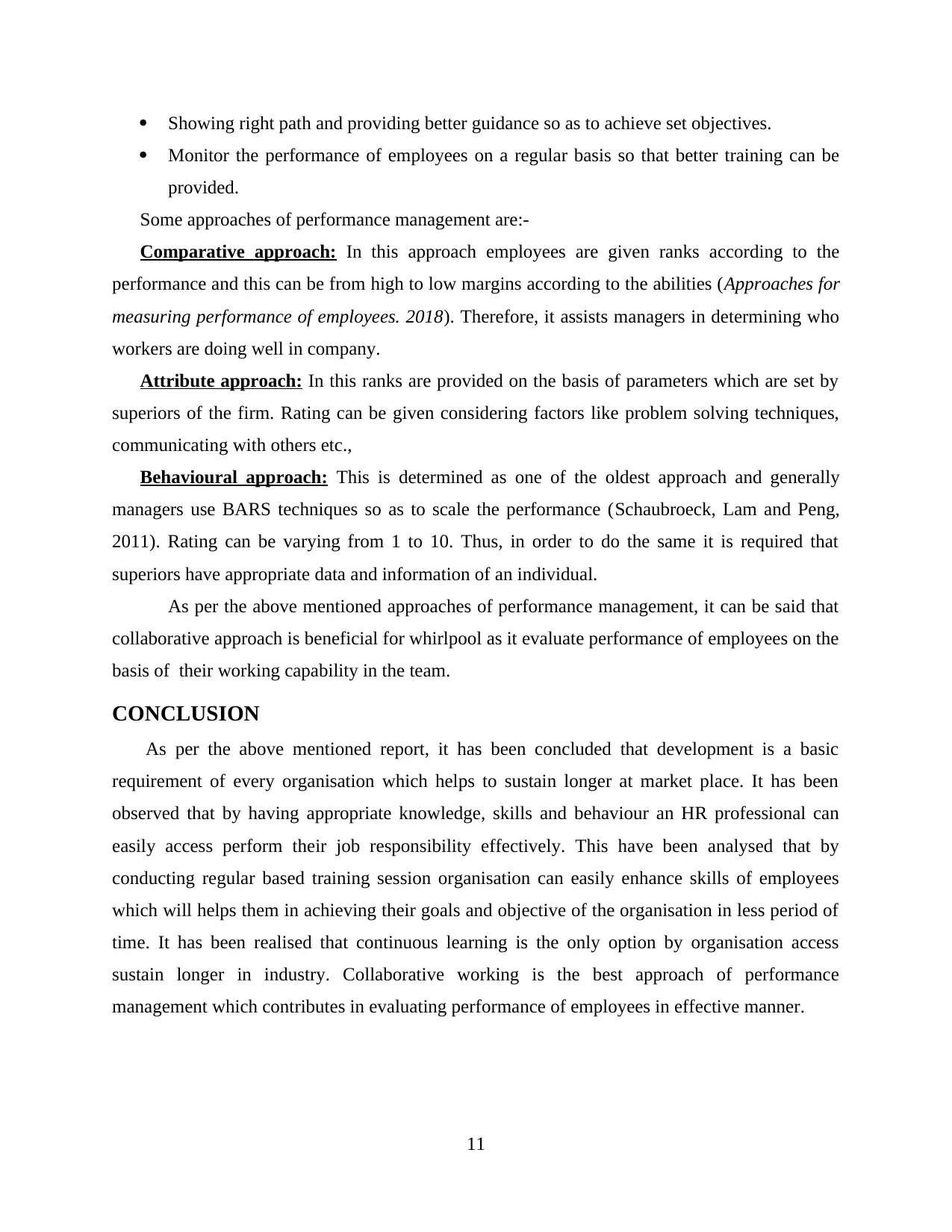
Showing right path and providing better guidance so as to achieve set objectives.
Monitor the performance of employees on a regular basis so that better training can be
provided.
Some approaches of performance management are:-
Comparative approach: In this approach employees are given ranks according to the
performance and this can be from high to low margins according to the abilities (Approaches for
measuring performance of employees. 2018). Therefore, it assists managers in determining who
workers are doing well in company.
Attribute approach: In this ranks are provided on the basis of parameters which are set by
superiors of the firm. Rating can be given considering factors like problem solving techniques,
communicating with others etc.,
Behavioural approach: This is determined as one of the oldest approach and generally
managers use BARS techniques so as to scale the performance (Schaubroeck, Lam and Peng,
2011). Rating can be varying from 1 to 10. Thus, in order to do the same it is required that
superiors have appropriate data and information of an individual.
As per the above mentioned approaches of performance management, it can be said that
collaborative approach is beneficial for whirlpool as it evaluate performance of employees on the
basis of their working capability in the team.
CONCLUSION
As per the above mentioned report, it has been concluded that development is a basic
requirement of every organisation which helps to sustain longer at market place. It has been
observed that by having appropriate knowledge, skills and behaviour an HR professional can
easily access perform their job responsibility effectively. This have been analysed that by
conducting regular based training session organisation can easily enhance skills of employees
which will helps them in achieving their goals and objective of the organisation in less period of
time. It has been realised that continuous learning is the only option by organisation access
sustain longer in industry. Collaborative working is the best approach of performance
management which contributes in evaluating performance of employees in effective manner.
11
Monitor the performance of employees on a regular basis so that better training can be
provided.
Some approaches of performance management are:-
Comparative approach: In this approach employees are given ranks according to the
performance and this can be from high to low margins according to the abilities (Approaches for
measuring performance of employees. 2018). Therefore, it assists managers in determining who
workers are doing well in company.
Attribute approach: In this ranks are provided on the basis of parameters which are set by
superiors of the firm. Rating can be given considering factors like problem solving techniques,
communicating with others etc.,
Behavioural approach: This is determined as one of the oldest approach and generally
managers use BARS techniques so as to scale the performance (Schaubroeck, Lam and Peng,
2011). Rating can be varying from 1 to 10. Thus, in order to do the same it is required that
superiors have appropriate data and information of an individual.
As per the above mentioned approaches of performance management, it can be said that
collaborative approach is beneficial for whirlpool as it evaluate performance of employees on the
basis of their working capability in the team.
CONCLUSION
As per the above mentioned report, it has been concluded that development is a basic
requirement of every organisation which helps to sustain longer at market place. It has been
observed that by having appropriate knowledge, skills and behaviour an HR professional can
easily access perform their job responsibility effectively. This have been analysed that by
conducting regular based training session organisation can easily enhance skills of employees
which will helps them in achieving their goals and objective of the organisation in less period of
time. It has been realised that continuous learning is the only option by organisation access
sustain longer in industry. Collaborative working is the best approach of performance
management which contributes in evaluating performance of employees in effective manner.
11
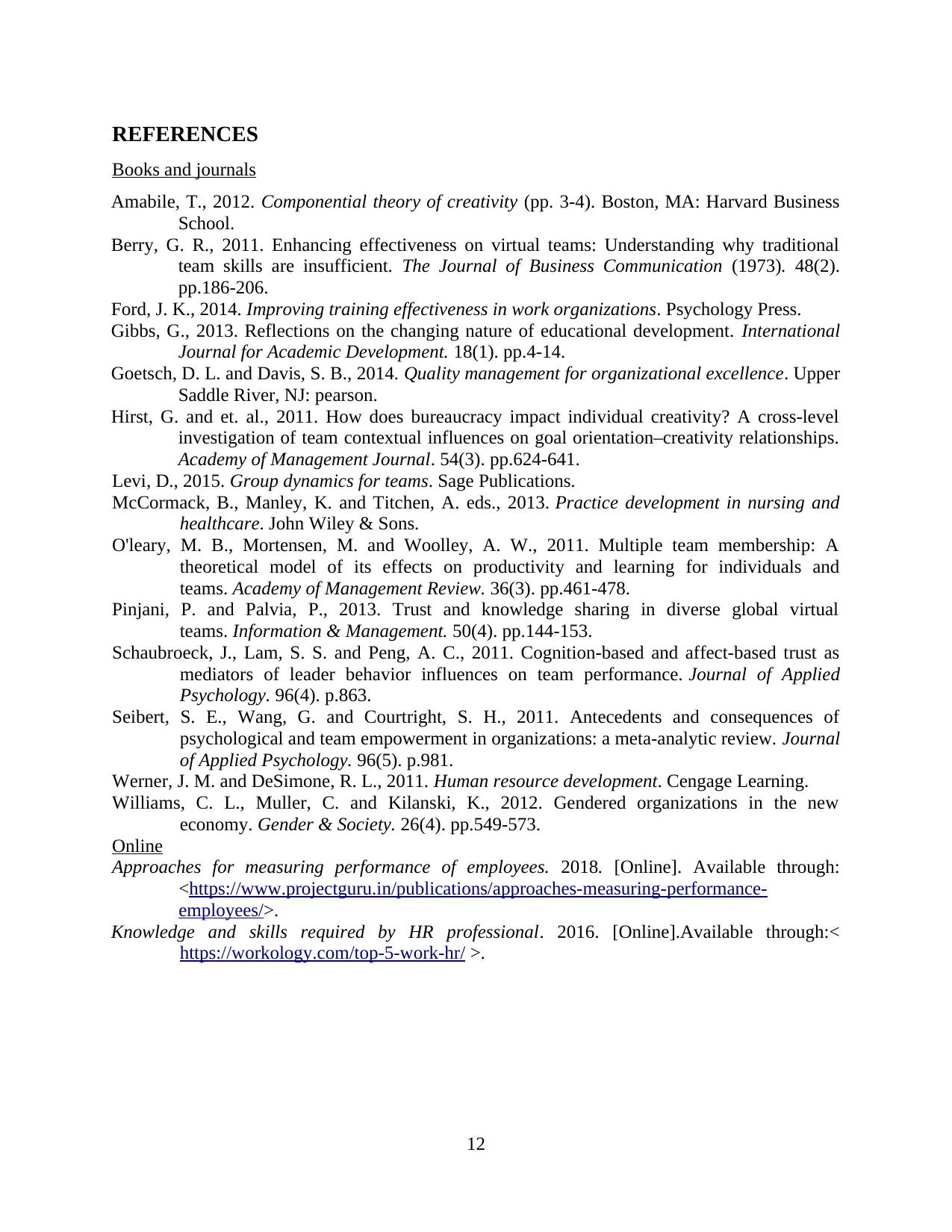
REFERENCES
Books and journals
Amabile, T., 2012. Componential theory of creativity (pp. 3-4). Boston, MA: Harvard Business
School.
Berry, G. R., 2011. Enhancing effectiveness on virtual teams: Understanding why traditional
team skills are insufficient. The Journal of Business Communication (1973). 48(2).
pp.186-206.
Ford, J. K., 2014. Improving training effectiveness in work organizations. Psychology Press.
Gibbs, G., 2013. Reflections on the changing nature of educational development. International
Journal for Academic Development. 18(1). pp.4-14.
Goetsch, D. L. and Davis, S. B., 2014. Quality management for organizational excellence. Upper
Saddle River, NJ: pearson.
Hirst, G. and et. al., 2011. How does bureaucracy impact individual creativity? A cross-level
investigation of team contextual influences on goal orientation–creativity relationships.
Academy of Management Journal. 54(3). pp.624-641.
Levi, D., 2015. Group dynamics for teams. Sage Publications.
McCormack, B., Manley, K. and Titchen, A. eds., 2013. Practice development in nursing and
healthcare. John Wiley & Sons.
O'leary, M. B., Mortensen, M. and Woolley, A. W., 2011. Multiple team membership: A
theoretical model of its effects on productivity and learning for individuals and
teams. Academy of Management Review. 36(3). pp.461-478.
Pinjani, P. and Palvia, P., 2013. Trust and knowledge sharing in diverse global virtual
teams. Information & Management. 50(4). pp.144-153.
Schaubroeck, J., Lam, S. S. and Peng, A. C., 2011. Cognition-based and affect-based trust as
mediators of leader behavior influences on team performance. Journal of Applied
Psychology. 96(4). p.863.
Seibert, S. E., Wang, G. and Courtright, S. H., 2011. Antecedents and consequences of
psychological and team empowerment in organizations: a meta-analytic review. Journal
of Applied Psychology. 96(5). p.981.
Werner, J. M. and DeSimone, R. L., 2011. Human resource development. Cengage Learning.
Williams, C. L., Muller, C. and Kilanski, K., 2012. Gendered organizations in the new
economy. Gender & Society. 26(4). pp.549-573.
Online
Approaches for measuring performance of employees. 2018. [Online]. Available through:
<https://www.projectguru.in/publications/approaches-measuring-performance-
employees/>.
Knowledge and skills required by HR professional. 2016. [Online].Available through:<
https://workology.com/top-5-work-hr/ >.
12
Books and journals
Amabile, T., 2012. Componential theory of creativity (pp. 3-4). Boston, MA: Harvard Business
School.
Berry, G. R., 2011. Enhancing effectiveness on virtual teams: Understanding why traditional
team skills are insufficient. The Journal of Business Communication (1973). 48(2).
pp.186-206.
Ford, J. K., 2014. Improving training effectiveness in work organizations. Psychology Press.
Gibbs, G., 2013. Reflections on the changing nature of educational development. International
Journal for Academic Development. 18(1). pp.4-14.
Goetsch, D. L. and Davis, S. B., 2014. Quality management for organizational excellence. Upper
Saddle River, NJ: pearson.
Hirst, G. and et. al., 2011. How does bureaucracy impact individual creativity? A cross-level
investigation of team contextual influences on goal orientation–creativity relationships.
Academy of Management Journal. 54(3). pp.624-641.
Levi, D., 2015. Group dynamics for teams. Sage Publications.
McCormack, B., Manley, K. and Titchen, A. eds., 2013. Practice development in nursing and
healthcare. John Wiley & Sons.
O'leary, M. B., Mortensen, M. and Woolley, A. W., 2011. Multiple team membership: A
theoretical model of its effects on productivity and learning for individuals and
teams. Academy of Management Review. 36(3). pp.461-478.
Pinjani, P. and Palvia, P., 2013. Trust and knowledge sharing in diverse global virtual
teams. Information & Management. 50(4). pp.144-153.
Schaubroeck, J., Lam, S. S. and Peng, A. C., 2011. Cognition-based and affect-based trust as
mediators of leader behavior influences on team performance. Journal of Applied
Psychology. 96(4). p.863.
Seibert, S. E., Wang, G. and Courtright, S. H., 2011. Antecedents and consequences of
psychological and team empowerment in organizations: a meta-analytic review. Journal
of Applied Psychology. 96(5). p.981.
Werner, J. M. and DeSimone, R. L., 2011. Human resource development. Cengage Learning.
Williams, C. L., Muller, C. and Kilanski, K., 2012. Gendered organizations in the new
economy. Gender & Society. 26(4). pp.549-573.
Online
Approaches for measuring performance of employees. 2018. [Online]. Available through:
<https://www.projectguru.in/publications/approaches-measuring-performance-
employees/>.
Knowledge and skills required by HR professional. 2016. [Online].Available through:<
https://workology.com/top-5-work-hr/ >.
12
⊘ This is a preview!⊘
Do you want full access?
Subscribe today to unlock all pages.

Trusted by 1+ million students worldwide
1 out of 12
Related Documents
Your All-in-One AI-Powered Toolkit for Academic Success.
+13062052269
info@desklib.com
Available 24*7 on WhatsApp / Email
![[object Object]](/_next/static/media/star-bottom.7253800d.svg)
Unlock your academic potential
Copyright © 2020–2025 A2Z Services. All Rights Reserved. Developed and managed by ZUCOL.





